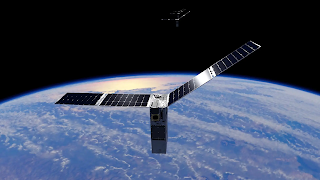NASA Starling mission is testing swarm technology in outer space
🛰️ Starling's mission consists of launching four small CubeSats into Earth orbit to test their ability to cooperate independently without immediate updates from the mission control center.
🔬 This mission aims to test key technologies that open the door to the future of deep space missions, where outer space is important for complex and autonomous space devices.
⚙️ Four key capabilities are being tested for the Starling mission: autonomous motion control to stay together as a team, create an adaptable communication network between satellites, track relative positions between them, and respond to new information from sensors by autonomously carrying out new activities.
🌐 Starling aims to create a swarm of small moons that can function as an autonomous community, capable of adapting to the environment and completing tasks as a team.
🚀 The Starling mission uses swarm technology for scientific measurements from multiple points in space, building networks capable of repairing themselves in the event of a part failure, and operating satellite systems that do not need constant communication with Earth to respond to changes in the environment.
🌌 The Starling mission will experiment on four key technologies, including the ROMEO Autonomous Maneuvering Experiment, the Wireless MANET Network, StarFOX Star-Sensor Surveillance, the DSA Experiment to collect scientific data and collaborate on improved data collection.
🌐 After the core mission, Starling will work with SpaceX's Starlink constellation to test advanced space traffic management techniques between autonomous space spacemachines from different organizations.
🤖 Robots always promote space exploration, both crewed and unmanned. The ability of satellites and spacecraft to operate in self-networked, coordinated capacity means that NASA ensures humanity can advance and conduct better science than ever before.
Title: Advancing Deep Space Missions: Astronauts of NASA's Starling Mission
NASA's Starling mission is set to launch a team of four CubeSats into Earth orbit with the goal of testing autonomous collaboration between robotic satellites. By acting as a swarm, these small satellites will explore key technologies vital to the future of deep space missions. The mission aims to strengthen NASA's capabilities for scientific exploration and lay the foundation for a new era of coordinated and autonomous spacecraft.
Autonomous cooperation and robotic squadrons:
Starling's mission seeks to demonstrate that small satellites can function as an independent community, respond to their environment and work together to accomplish tasks. The four cubic satellites will be deployed in two different configurations, flying 355 miles above the Earth and diverging approximately 40 miles. Over a period of six months, they will undergo rigorous testing to assess their abilities in several key areas.
Main techniques and capabilities:
Starling's mission will focus on testing four main abilities:
1. Autonomous maneuvering: Cube satellites will show the ability to maneuver independently and maintain modulation as a group. This capability is essential for future deep space missions where coordinated movement and site control are essential.
2. Adaptable communication network: The spacecraft will create an adaptable communications network using a dedicated mobile network system (MANET). This network will enable seamless communication between satellites, improve data routing and ensure strong communication.
3. Relative position tracking: Each CubeSat will use "star tracker" sensors to monitor its direction in space. In addition, these sensors will detect light emitted by other warship spacecraft, enabling accurate tracking of the relative position of the entire squadron.
4. Responsive autonomy: The Distributed Spacecraft Autonomy (DSA) experience will demonstrate the swarm's ability to independently collect and analyze scientific data. If one satellite detects something interesting, it will communicate with others to observe the same phenomenon, enhancing data collection capabilities.
Benefits of swarm techniques:
Swarm technologies offer many advantages for space missions. Multiple measurement points enable comprehensive scientific observations. The self-patching ability of the network ensures system flexibility and redundancy, mitigating the impact of malfunctions within the swarm. Moreover, these technologies allow spacecraft systems to operate autonomously, reducing dependence on real-time communication with the Earth.
Implications and future cooperation:
After the initial Starling mission, NASA plans to collaborate with SpaceX's Starlink satellite constellation to test advanced technologies for managing space traffic between autonomous spacecraft operated by various organizations. This partnership aims to create an automated system that ensures safe operations of satellites in low Earth orbit.
Conclusion:
NASA's Starling mission represents a major leap forward in the development of swarm technologies for deep space exploration. By demonstrating independent collaboration and advanced capabilities, such as maneuvering, communication, location tracking, and data optimization, this mission paves the way for future scientific and exploratory missions. With swarm technologies at the forefront, NASA is poised to push humanity to new heights and unlock unprecedented scientific discoveries.

